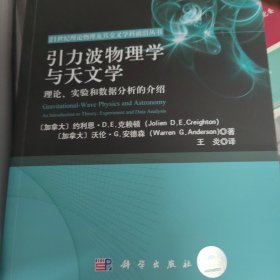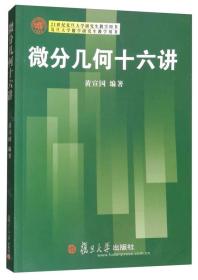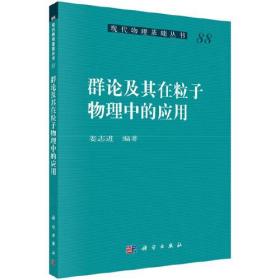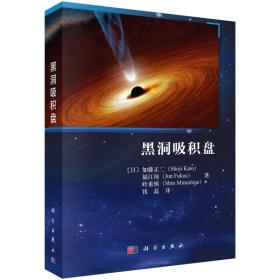
中外物理学精品书系:现代粒子物理学导论(第三版)(英文影印版)
¥ 74 6.4折 ¥ 116 全新
仅1件
山东济南
认证卖家担保交易快速发货售后保障
作者[巴基斯坦]法耶兹丁(Fayyazuddin)、[巴基斯坦]里亚兹丁 著
出版社北京大学出版社
出版时间2015-01
版次1
装帧平装
上书时间2024-05-21
- 在售商品 暂无
- 平均发货时间 10小时
- 好评率 暂无
- 最新上架
商品详情
- 品相描述:全新
图书标准信息
- 作者 [巴基斯坦]法耶兹丁(Fayyazuddin)、[巴基斯坦]里亚兹丁 著
- 出版社 北京大学出版社
- 出版时间 2015-01
- 版次 1
- ISBN 9787301251744
- 定价 116.00元
- 装帧 平装
- 开本 16开
- 纸张 胶版纸
- 页数 684页
- 字数 683千字
- 丛书 中外物理学精品书系
- 【内容简介】
-
《中外物理学精品书系:现代粒子物理学导论(第三版)(英文影印版)》涵盖了粒子物理各种方向,包括量子电动力学、夸克模型、标准模型等等。在理论和实验两方面都进行了系统讲解。此外,本书还着重讨论了天体物理、宇宙学和粒子物理学的交叉研究,即天体粒子物理学。
《中外物理学精品书系:现代粒子物理学导论(第三版)(英文影印版)》适合粒子物理、核物理、天体物理等领域的研究者和研究生阅读。 - 【作者简介】
- (巴基斯坦)法耶兹丁,巴基斯坦国家物理中心教授。
- 【目录】
-
Preface vii1. Introduction 11.1 Fundamental Forces . 11.1.1 The Gravitational Force 21.1.2 The Weak Nuclear Force 21.1.3 The Electromagnetic Force . 31.1.4 The Strong Nuclear Force 41.2 Relative Strength of Four Fundamental Forces 41.3 Range of the Three Basic Forces 51.4 Classi_cation of Matter . 71.5 Strong Color Charges 91.6 Fundamental Role of \Charges" in the Uni_cation of Forces 101.7 Strong Quark-Quark Force . 161.8 Grand Uni_cation 181.9 Units and Notation 191.10 Problems . 211.11 References . 212. Scattering and Particle Interaction 232.1 Introduction 232.2 Kinematics of a Scattering Process . 262.3 Interaction Picture 312.4 Scattering Matrix (S-Matrix) 322.5 Phase Space 362.6 Examples . 392.6.1 Two-body Scattering 392.6.2 Three-body Decay 412.7 Electromagnetic Interaction . 502.8 Weak Interaction . 522.9 Hadronic Cross-section 552.10 Problems . 562.11 References . 583. Space-Time Symmetries 593.1 Introduction 593.1.1 Rotation and SO(3) Group . 603.1.2 Translation 623.1.3 Lorentz Group 633.2 Invariance Principle . 653.2.1 U Continuous 653.2.2 U is Discrete (e.g. Space Reection) 663.3 Parity . 663.4 Intrinsic Parity 683.4.1 Intrinsic Parity of Pion . 703.5 Parity Constraints on S-Matrix for Hadronic Reactions 713.5.1 Scattering of Spin 0 Particles on Spin 12 Particles 713.5.2 Decay of a Spin 0+ Particle into Three SpinlessParticles Each Having Odd Parity . 723.6 Time Reversal 733.6.1 Unitarity . 743.6.2 Reciprocity Relation . 753.7 Applications 763.7.1 Detailed Balance Principle . 763.8 Unitarity Constraints 773.8.1 Two-Particle Partial Wave Unitarity 793.9 Problems . 853.10 References . 904. Internal Symmetries 914.1 Selection Rules and Globally Conserved Quantum Numbers 914.2 Isospin . 974.2.1 Electromagnetic Interaction and Isospin 1004.2.2 Weak Interaction and Isospin 1014.3 Resonance Production 1014.3.1 _-resonance . 1034.3.2 Spin of _ . 1034.4 Charge Conjugation . 1074.5 G-Parity 1124.6 Problems . 1134.7 References . 1175. Unitary Groups and SU(3) 1195.1 Unitary Groups and SU(3) . 1195.2 Particle Representations in Flavor SU(3) 1245.2.1 Mesons 1265.2.2 Baryons 1285.3 U-Spin . 1325.4 Irreducible Representations of SU(3) 1345.4.1 Young's Tableaux 1355.5 SU(N) . 1415.6 Applications of Flavor SU(3) 1455.6.1 SU(3) Invariant BBP Couplings 1455.6.2 VPP Coupling 1465.7 Mass Splitting in Flavor SU(3) . 1485.8 Problems . 1545.9 References . 1586. SU(6) and Quark Model 1596.1 SU(6) . 1596.1.1 SU(6) Wave Function for Mesons . 1606.2 Magnetic Moments of Baryons . 1646.3 Radiative Decays of Vector Mesons . 1706.4 Radiative Decays (Complementary Derivation) 1766.4.1 Mesonic Radiative Decays V = P + . 1766.4.2 Baryonic Radiative Decay . 1776.5 Problems . 1796.6 References . 1807. Color, Gauge Principle and Quantum Chromodynamics 1817.1 Evidence for Color 1817.2 Gauge Principle 1847.2.1 Aharanov and Bohm Experiment . 1867.2.2 Gauge Principle for Relativistic Quantum Mechanics 1887.3 Non-Abelion Local Gauge Transformations (Yang-Mills) . 1907.4 Quantum Chromodynamics (QCD) . 1947.4.1 Conserved Current . 1977.4.2 Experimental Determinations of _s(q2) andAsymptotic Freedom of QCD 1997.5 Hadron Spectroscopy . 2027.5.1 One Gluon Exchange Potential . 2027.5.2 Long Range QCD Motivated Potential 2057.5.3 Spin-Spin Interaction 2097.6 The Mass Spectrum . 2097.6.1 Meson Mass Relations 2117.6.2 Baryon Mass Spectrum . 2137.7 Problems . 2177.8 References . 2198. Heavy Flavors 2218.1 Discovery of Charm . 2218.1.1 Isospin 2238.1.2 SU(3) Classi_cation . 2238.2 Charm . 2248.2.1 Heavy Mesons 2248.2.2 The Fifth Quark Flavor: Bottom Mesons . 2288.2.3 The Sixth Quark Flavor: The Top . 2288.3 Strong and Radiative Decays of D_ Mesons 2298.4 Heavy Baryons 2328.5 Quarkonium 2338.6 Leptonic Decay Width of Quarkonium . 2378.7 Hadronic Decay Width 2388.8 Non-Relativistic Treatment of Quarkonium 2408.9 Observations . 2458.10 Tetraquark 2468.11 Problems . 2498.12 References . 2549. Heavy Quark E_ective Theory 2559.1 E_ective Lagrangian . 2559.2 Spin Symmetry of Heavy Quark . 2599.3 Mass Spectroscopy for Hadrons with One Heavy Quark . 2649.4 The P-wave Heavy Mesons: Mass Spectroscopy 2699.5 Decays of P-wave Mesons 2759.6 Problems . 2779.7 References . 27710. Weak Interaction 27910.1 V ?? A Interaction 27910.1.1 Helicity of the Neutrino . 28110.2 Classi_cation of Weak Processes 28110.2.1 Purely Leptonic Processes . 28110.2.2 Semileptonic Processes . 28310.2.3 Non-Leptonic Processes . 28710.2.4 _-Decay . 28810.2.5 Remarks . 28910.2.6 Semi-Leptonic Processes 29110.3 Baryon Decays 29210.4 Pseudoscalar Meson Decays . 29610.4.1 Pion Decay 29610.4.2 Strangeness Changing Semi-Leptonic Decays . 29710.5 Hadronic Weak Decays 29910.5.1 Non-Leptonic Decays of Hyperons . 29910.5.2 _I = 1/2 Rule for Hyperon Decays 30210.5.3 Non-leptonic Hyperon Decays in Non-RelativisticQuark Model . 30410.6 Problems . 30710.7 References . 31011. Properties of Weak Hadronic Currents and Chiral Symmetry 31111.1 Introduction 31111.2 Conserved Vector Current Hypothesis (CVC) . 31111.3 Partially Conserved Axial Vector Current Hypothesis(PCAC) 31411.4 Current Algebra and Chiral Symmetry . 31711.4.1 Explicit Breaking of Chiral Symmetry . 32011.4.2 An Application of Chiral Symmetry to Non-Leptonic Decays of Hyperons 32311.5 Axial Anomaly 32511.6 QCD Sum Rules . 32711.7 Problems . 32811.8 References . 32912. Neutrino 33112.1 Introduction 33112.2 Intrinsic Properties of Neutrinos 33212.3 Mass 33212.3.1 Constraints on Neutrino Mass . 33312.3.2 Dirac and Majorana Masses 33712.3.3 Fermion Masses in the Standard Model (SM) andSee-saw Mechanism . 33912.4 Neutrino Oscillations . 34312.4.1 Mikheyev-Smirnov-Wolfenstein E_ect . 34512.4.2 Evolution of Flavor Eigenstates in Matter . 34912.5 Evidence for Neutrino Oscillations . 35112.5.1 Disappearance Experiments 35112.5.2 Appearance Experiments 35112.6 Neutrino Mass Models and Mixing Matrix and Symmetries 35512.7 Neutrino Magnetic Moment . 36012.8 Problems . 36212.9 References . 36313. Electroweak Uni_cation 36513.1 Introduction 36513.2 Spontaneous Symmetry Breaking and Higgs Mechanism . 36613.2.1 Higgs Mechanism 36813.2.2 Gauge Symmetry Breaking for Chiral U1U2 Group 36913.3 Renormalizability . 37213.4 Electroweak Uni_cation . 37413.4.1 Experimental Consequences of the ElectroweakUni_cation 38113.4.2 Need for Radiative Corrections . 38213.4.3 Experiments which Determine sin2 _W 38713.5 Decay Widths of W and Z Bosons . 38913.6 Tests of Yang-Mills Character of Gauge Bosons 39513.7 Higgs Boson Mass 39913.8 Upper Bound . 39913.8.1 Unitarity . 39913.8.2 Finiteness of Couplings . 40013.9 Standard Model, Higgs Boson Searches, Production at Decays40113.9.1 LEP-2 40113.9.2 LHC and Tevatron . 40213.10 Two Higgs Doublet Model (2HDM) . 40613.11 GIM Mechanism . 41113.12 Cabibbo-Kobayashi-Maskawa Matrix 41413.13 Axial Anomaly 41613.14 Problems . 42113.15 References . 42314. Deep Inelastic Scattering 42514.1 Introduction 42514.2 Deep-Inelastic Lepton-Nucleon Scattering . 42714.3 Parton Model . 43114.4 Deep Inelastic Neutrino-Nucleon Scattering 43614.5 Sum Rules . 43914.6 Deep-Inelastic Scattering Involving Neutral Weak Currents 44614.7 Problems . 44714.8 References . 45015. Weak Decays of Heavy Flavors 45115.1 Leptonic Decays of _ Lepton 45115.2 Semi-Hadronic Decays of _ Lepton . 45315.2.1 Special Cases . 45415.3 Weak Decays of Heavy Flavors . 45715.3.1 Leptonic Decays of D and B Mesons . 45815.3.2 Semileptonic Decays of D and B Mesons . 45915.3.3 (Exclusive) Semileptonic Decays of D and B Mesons 46415.3.4 Weak Hadronic Decays of B Mesons 47115.3.5 Inclusive Hadronic B Decays 47615.3.6 Radiative Decays of Bq Mesons 47815.4 Inclusive Hadronic Decays of D-Mesons 47915.4.1 Scattering and Annihilation Diagrams . 48015.5 Problems . 48415.6 References . 48716. Particle Mixing and CP-Violation 48916.1 Introduction 48916.2 CPT and CP Invariance . 49216.3 CP-Violation in the Standard Model 49416.4 Particle Mixing 49716.5 K0 ?? _K0 Complex and CP-Violation in K-Decay . 50416.6 B0 ?? _B0 Complex 51116.7 CP-Violation in B-Decays 51516.8 CP-Violation in Hadronic Weak Decays of Baryons 51816.9 Problems . 52216.10 References . 52317. Grand Uni_cation, Supersymmetry and Strings 52517.1 Grand Uni_cation 52517.1.1 q2 Evolution of Gauge Coupling Constants and theGrand Uni_cation Mass Scale . 52917.1.2 General Consequences of GUTS 53117.2 Poincar_e Group and Supersymmetry 53417.2.1 Introduction . 53417.2.2 Poincar_e group . 53717.2.3 Two-Component Weyl Spinors . 53917.2.4 Spinor Algebra, Supersymmetry 54017.2.5 Supersymmetric Multiplets . 54217.3 Supersymmetry and Strings . 54417.3.1 Introduction . 54417.3.2 Supersymmetry . 54517.4 String Theory and Duality 54817.4.1 M-theory . 55017.5 Some Important Results . 55217.6 Conclusions 55217.7 Problems . 55217.8 References . 55418. Cosmology and Astroparticle Physics 55718.1 Cosmological Principle and Expansion of the Universe 55718.2 The Standard Model of Cosmology . 559G18.3 Cosmological Parameters and the Standard Model Solutions 56218.4 Accelerating Universe and Dark Energy 56618.4.1 Evidence from Supernovae . 56718.4.2 Evidence from CMB Data . 56818.4.3 Quintessence . 57118.4.4 Modi_ed Gravity 57318.5 Hot Big Bang: Thermal History of the Universe 57418.5.1 Thermal Equilibrium 57418.5.2 The Radiation Era . 57618.6 Freeze Out 58118.7 Limit on Neutrino Mass . 58418.8 Primordial Nucleosynthesis . 58518.9 Ination 58818.9.1 Horizon Problem . 58818.9.2 Flatness Problem 59018.9.3 Realization of Ination . 59118.9.4 Slow-roll Ination 59318.10 Baryogenesis . 59518.10.1 Sakharov's Conditions 59718.10.2 Various Scenarios for Baryogenesis . 59818.10.3 Leptogenesis . 60118.11 Problems . 60618.12 References . 607Appendix A Quantum Field Theory 609A.1 Spin 0 Field 609A.2 Spin 1/2 Particle . 611A.2.1 Pauli Representation of Matrices 612A.2.2 Weyl Representation of Matrices . 613A.3 Trace of Matrices 616A.4 Spin 1 Field 618A.5 Massive Spin 1 Particle . 619A.6 Feynman Rules for S-Matrix in Momentum Space . 620A.7 Application of Feynman Rules 621A.7.1 e+e??!Hadrons 624A.7.2 ElectronScatteringanStructurelessSpin1=2Target625A.8 Discrete Symmetries . 628A.8.1 Charge Conjugation . 628A.8.2 Space Reection . 631Electron Scattering and Structureless Spin 1=2 Target 625A.8.3 Time Reversal 632A.9 Problems . 633AppendixB Renormalization Group and Running Coupling Constant 639B.1 Feynman Rules for Quantum Chromodynamics 639B.2 Renormalization Group, Coupling Constant and AsymptoticFreedom . 640B.3 Running Coupling Constant in Quantum Electrodynamics(QED) . 645B.4 Running Coupling Constant for SU(2) Gauge Group . 646B.5 Renormalization Group and High Q2 Behavior of Green'sFunction 647B.5.1 Gluon Propagator 649B.5.2 Fermion Propagator . 650B.6 References for Appendices 652Index 653
点击展开
点击收起
相关推荐
— 没有更多了 —






















以下为对购买帮助不大的评价